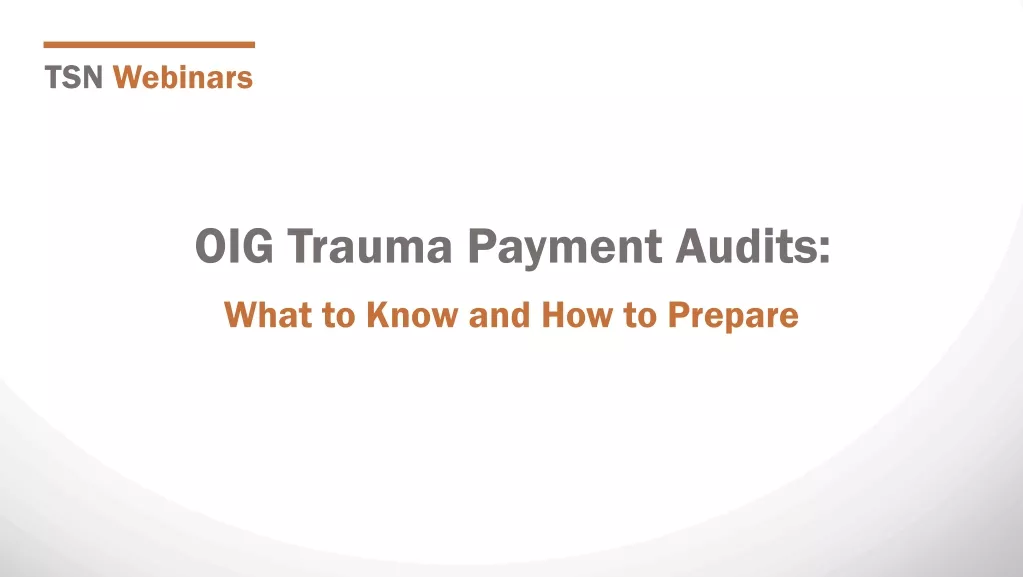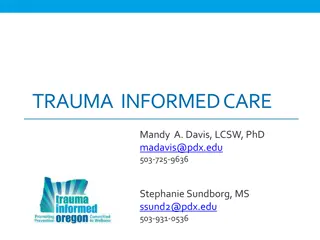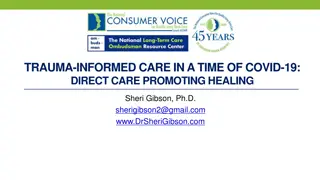From Power Over to Power With: Understanding Trauma-Informed Care
Psychological trauma results from events overwhelming an individual's control, connection, and meaning. Trauma-Informed Care shifts the focus from "What's wrong with you?" to "What happened to you?" Guiding principles include safety, trustworthiness, collaboration, empowerment, and cultural awareness.
Download Presentation

Please find below an Image/Link to download the presentation.
The content on the website is provided AS IS for your information and personal use only. It may not be sold, licensed, or shared on other websites without obtaining consent from the author. Download presentation by click this link. If you encounter any issues during the download, it is possible that the publisher has removed the file from their server.
E N D
Presentation Transcript
From Power Over to Power With: Applying Trauma Informed Care To Our Work ELIZABETH EASTLUND,LCSW EXECUTIVE DIRECTOR, RAINBOW SERVICES AMY TURK, LCSW CHIEF PROGRAM OFFICER, DOWNTOWN WOMEN S CENTER
What is Trauma? Psychological trauma is an affiliation of the powerless. At the moment of trauma, the victim is rendered helpless by overwhelming force. When the force is that of nature, we speak of disasters. When the force is that of other human beings, we speak of atrocities. Traumatic events overwhelm the ordinary systems of care that give people a sense of control, connection, and meaning. - Judith Herman
Other definitions of Trauma "...a trauma is any event or experience of sufficient force or magnitude that it overwhelms the capacity of the individual to absorb the experience and continue essentially unaffected, and which therefore results in a significant reduction or distortion of the individual s ability to carry on with normal behaviour, and to function adequately in their lives. -Robin Johnson
Trauma Informed Care a Cultural Shift From asking: What is wrong with you? To: What Happened to You? From Power OVER to Power WITH
What is Trauma Informed Care? "Trauma Informed Services assume that people are doing the best they can at any given time to cope with the life altering and frequently catastrophic effects of trauma. Because victimization can lead to disconnection with self and isolation from others, the challenge is to develop services that create authentic reconnection, reparation, and healing. A Long Journey Home; A guide for creating Trauma-Informed Services for Mothers and Children experiencing Homelessness
Guiding Principles of TIC SAFETY Trustworthiness and Transparency Peer Support and Mutual Self Help Collaboration and Mutuality Empowerment, Voice and Choice Cultural, Historical and Gender Issues
A Trauma Informed Approach Realizes Realizes the widespread impact of trauma and understands potential paths for recovery. Recognizes Recognizes the signs and symptoms of trauma in clients, families, staff, and others involved with the system. Responds Responds by fully integrating knowledge about trauma into policies, procedures, and practices. Seeks to actively resist re-traumatization.
Rainbows Journey to Implementing TIC Begins with how we communicate: with the participants, their children, and with each other. We want to set a collaborative tone in everything that we do. cultivating an environment of hopefulness Harris & Fallot
Rainbows Commitment to a Trauma Informed Culture Commitment to Learning Individual supervision Group Supervision Reflective Practice Regular Staff Training & Professional Development Wellness events - Cheerness Committee Regular evaluation Organizational Values Awards
What does a TI organization look like? Improved flexibility, consistency, adaptability to the needs of the individual and family Builds hope, decreases shame, empowers survivors to see their options
Rethinking Shelter From Rules to Guidelines From Rules to Guidelines Many revisions over the years which included input from shelter staff Main question: "Does this rule/guideline/expectation have anything to do with SAFETY? What risk are we taking if we let go of this rule? What may be the benefit of letting go? Requires being mindful of our language - "We offer these services, what do you think will work best for you and your family?" Saying You can t does not leave space to discuss options for being safer
A Call To Action Describe ways in which you are already applying the principles of TIC in your work. Discuss what changes you can make today in the ways in which you interact with survivors.
Downtown Womens Centers Journey towards a TIC Organization 1. Set the Stage 2. Complete Organizational Self-Assessment (pre and post) 3. Form Trauma-Informed Care Workgroup 4. Develop a Strategic Plan 5. Implement Trauma-Informed Changes 6. Contribute to Trauma-Informed Community Building through collaboration, advocacy, and training Fuarino, K., Soares, P., Konnath, K. Clervil, R., and Bassuk, E. (2009). Trauma-Informed Organizational Toolkit. Rockville, MD: Center for Mental Health Services, Substance Abuse and Mental Health Services Administration. Available at www.homeless.samhsa.gov and www.familyhomelessnss.org
Organizational Assessment Tools Trauma Informed Organizational Toolkit for Homeless Services Fuarino, K., Soares, P., Konnath, K. Clervil, R., and Bassuk, E. (2009). Trauma-Informed Organizational Toolkit. Rockville, MD: Center for Mental Health Services, Substance Abuse and Mental Health Services Administration. Available at www.homeless.samhsa.gov and www.familyhomelessness.org) American Institutes for Research s Trauma Informed Care Organizational Capacity Scale www.air.org The National Council s Trauma-Informed Care Organizational Self-Assessment https://www.thenationalcouncil.org/areas-of-expertise/trauma-informed-behavioral-healthcare/
Downtown Womens Centers Examples of Building a TIC Organization 1. Supporting Staff Development Early on-boarding, monthly staff training, annual retreat, weekly supervision Employee Assistance Program; Vicarious Trauma Prevention workgroup Staff satisfaction assessments; focus groups with third-party Training on TIC supervision 2. Establishing a Safe and Supportive Environment Safe physical surroundings; locks and lights work; staff have access to needed items to feel safe (panic buttons, security protocol) Consistency and confidentiality with the clients. 3. Assessing and Planning Services Intake and assessments are trauma-informed Client satisfaction surveys Clients are involved in program design 4. Adapting Policies Including staff feedback in policy procedures and strategic planning The program has a written statement that includes a commitment to understanding trauma and engaging in trauma-sensitive practices. The program has written policies outlining professional conduct for staff (e.g., boundaries, responses to consumers, etc.). 5. Evaluation and Continuous Quality Improvement Quarterly reports to reflect on implementing TIC/how client feedback was incorporated
TIC Organizational Responsibilities Organizations leadership communicates a TIC message Organizational stakeholders are trained and buy-in Job performance evaluations clearly describe TIC expectations The organization helps staff develop personally meaningful stress management strategies Compensation Safety protocols and training Invest in the work environment facility maintenance Balance workload Shared leadership Solicit input; demonstrate how staff input makes positive change
TIC Organizational Responsibilities Trauma-Informed Supervision Teach people how to debrief (sliming vs low-impact debriefing) Coach on how to keep things in perspective Strengths-based Fail Forward principals Set a good example Normalize and address Secondary Trauma; Create structure to discuss self-care Transparency Train in EBPs Training on importance to track and analyze data Balance workload
TIC Organizational Outcomes Increased better outcomes for individuals served Less staff turnover related to workplace dissatisfaction Productivity goals are met/Better outcomes for clients Stress related workers comp decreases Reduction of unplanned time off Staff surveys demonstrate higher satisfaction rates Client surveys demonstrate higher satisfaction rates/greater ability to reach goals
Why TIC Organizational Building is Important Compassion Satisfaction: Positive feelings derived from one s work making a meaningful contribution Burnout: Low job satisfaction, feel powerless and overwhelmed Compassion Fatigue: Profound emotional and physical exhaustion, erosion of empathy and hope for our clients and ourselves Vicarious/Secondary Trauma: Fundamental beliefs change; numbness, sadness, and/or anger toward unfairness of the world; can lead to PTSD

 undefined
undefined































